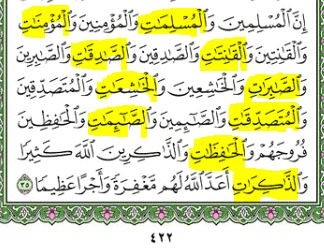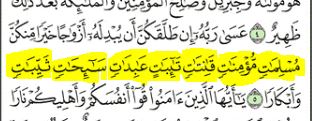
السلام عليكم و رحمة الله,
We’ve covered فتحة (fathah) and the letter ا as signs of نصب (nasb). Today we take a short look at the third sign, كَسرة (kasrah):
When كسرة substitutes for فتحة as a sign of نصب
وَأمّا الكَسْرَةُ فَتَكُوْنُ عَلامَةً لِلنَصْبِ فِي جَمْعِ المُؤَنَّثِ السالِمِ
As for the kasrah, then it is a sign of nasb in the sound feminine plural.
You already know what the “sound feminine plural” is from Going high with رفع, Part 1: ضمة and now we tell you that you can figure out that a sound feminine plural is in nasb if it has a kasrah at the end.
For example, إنَّ الفَتياتِ المُهَذَّباتِ يُدْرِكْنَ المَجدَ (“Indeed, the refined girls will attain glory”). Each of the words الفتياتِ and المُهذباتِ is a sound feminine plural, and they are both in nasb, the first because of the word إنَّ (which is one of the nasb-izers of nouns) and the second is a description of an اسم that is in nasb state. The indication of their nasb state is the kasrah, substituting for the fathah.
Two things to note here:
- إنّ and its siblings will force a noun to be in nasb. We will learn more about إنَّ and its siblings in a separate section إن شاء الله
- If a word is meant to be used as a description for another word, then both words will have the same status. This will become clearer in a later section on “grammatical followers”. For now just know that the noun that is being described and the description will have the same status (as well as the same gender, number and definite/indefiniteness). In our example, الفتياتِ (“the girls”) is being described and is in nasb because of إنَّ. The word المُهَذَّباتِ (“the refined”) is the description. الفَتَيات and its description المُهَذَّباتِ are both:
- definite (you can tell by the ال before them)
- feminine plural (you can tell by the ات ending)
- in nasb (you can tell by the kasrah at the end)
From the Quran
From Surah 33:35, I’ve highlighted some feminine plurals that are showing their nasb using a kasrah at the end. They are all in nasb because each one of them is connected by وَ (“and”) to a word that is already in nasb. The very first word in the chain is المُسلِمِينَ, and it is in nasb because of our old friend إنَ which nasb-izes nouns. All the other words follow it using وَ.

Below is Surah 66:5

- The word أزواجاً (“wives”) here is in nasb because it’s a direct object of يُبْدِلَهُ (“He substitutes for him”). It’s an indefinite noun because it doesn’t fall into any of the categories of the definite noun (more on that later إن شاء الله).
- The highlighted words are all descriptions for the أزواجًا (“wives”). To match the word that they are describing, they are feminine plurals in nasb and also indefinite.
- You might think that, أزْواجًا doesn’t look like a feminine plural because it doesn’t have ات at the end, but it does carry the meaning of a feminine plural. Sometimes there’s just no substitute for knowing the meaning of the words we’re dealing with.
This is the only situation in which the kasrah substitutes for fathah as a sign of nasb.
Exercise
Make feminine plurals out of the following words using ات at the end:
- العَاقِلَةُ (“the intelligent one”)
- فاطِمَةُ (Fatimah)
- سُعْدى (happier)
- المُدَرِّسَةُ (“the teacher”)
- المُهّذَّبَةُ (“the refined one”)
- الحَمَّامُ (dove)
- ذِكْرى (reminder)
Question
- In how many situations does kasrah substitute for fathah as the sign of nasb?
Until next time, السلام عليكم و رحمة الله و بركاته
Like this post? Simply enter your e-mail and click “Yes, include me!” for updates
Leave a Reply